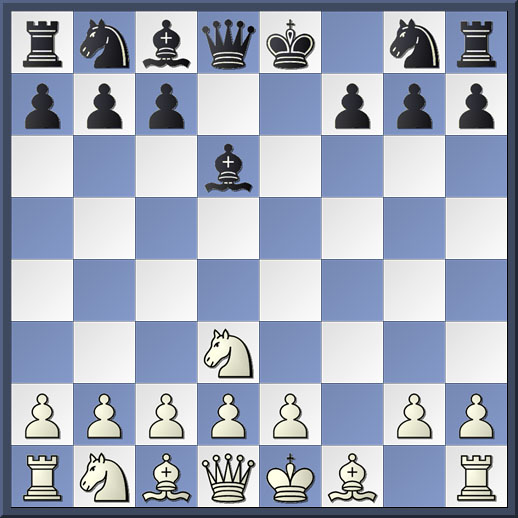An Oddball Bird
If White intends to play 1.f4, Bird's Opening, he can expect to meet From's Gambit with 1...e5 fairly often. This popular attack guarantees an exciting game with many complicated byways, and both players have to know a bit of theory if they are to fight on equal terms. But if White can early on direct the game into uncharted territory - uncharted for his opponent! - then his chances of success are much improved.
After 1.f4 e5 2.fxe5 d6 3.Nf3 dxe5 4.Nxe5 Bd6 White usually goes 5.Nf3, which returns to a "normal" From's Gambit, each side having used an extra move over the regular sequence 1.f4 e5 2.fxe5 d6 3.exd6 Bxd6 4.Nf3, etc. However, the present order of moves allows White the extra option of 5.Nd3!?, seen in the diagram below.

This strange retreat is either not discussed in opening manuals, or dismissed in footnotes as a simple error. However, a few minutes of analysis should convince skeptics of White's fundamental health in this position. Here we offer one of the few games featuring this variation, with a few notes to stimulate discussion.
[Event "cr NM-1991"] [Site "?"] [Date "1991.??.??"] [Round "?"] [White "Westersss, Magne"] [Black "Isaksen, Kjell Otto"] [Result "1-0"] [ECO "A02"] [Annotator "Pickard, S."] [PlyCount "67"] [EventDate "1991.??.??"] [EventType "swiss"] [SourceTitle "Big Bird PowerBase"] [Source "Pickard & Son"] [SourceDate "2009.01.01"] 1. f4 e5 2. fxe5 d6 3. Nf3 dxe5 4. Nxe5 Bd6 5. Nd3 $5 $13 {(Provocative, and only possible in this move order of From's gambit.)} Qh4+ ({Developing with} 5... Nf6 {has been played, a reasonable way to seek compensation for the sacrificed pawn. For example} 6. e3 Ng4 7. g3 h5 8. Qf3 $13 {is quite murky.}) 6. Nf2 {[%cal Yg2g3]} Bxh2 {(The only way to justify his last move.)} 7. d4 $1 Nf6 8. Nd2 Qg3 $5 ({The direct} 8... Ng4 {meets with} 9. Nde4 Nxf2 ({if} 9... f5 $5 {then} 10. g3 $14) 10. Nxf2 Nc6 11. e4 $14 {and Black still has to untangle.}) ({Perhaps balance can be maintained by} 8... Nc6 9. c3 Ng4 10. Nde4 Bf5 11. Bg5 $13 {and the situation is unclear.}) 9. a4 $1 Bf5 $6 ({Black should ready a retreat with} 9... c5 {but after} 10. Ra3 Qc7 11. Nde4 Nxe4 12. Nxe4 $14 {White begins to consolidate.}) 10. e4 $16 {(Material is even, but White has a nice advantage.)} Bg4 11. Be2 Bxe2 12. Qxe2 Qxg2 13. Qf1 Qxf1+ 14. Nxf1 Bd6 15. e5 Bb4+ 16. c3 Nd5 17. cxb4 Nxb4 18. Ne3 {(White's extra piece will tell quickly now.)} N8c6 19. Bd2 O-O-O 20. Bc3 h5 21. O-O Nd5 22. Nxd5 Rxd5 23. Nh3 Nxd4 24. Rae1 c5 25. Rxf7 Re8 26. Bxd4 cxd4 27. Rc1+ Kb8 28. Rcc7 Rexe5 29. Rxb7+ Kc8 30. Rxa7 Kb8 31. Rfb7+ Kc8 32. Rxg7 Kb8 33. Rab7+ Ka8 34. Nf4 1-0
"Fascinating", as Spock would say. And should White need more encouragement to try this unexplored system, it should be observed that he holds a slight plus in the handful of 5.Nd3!? games available. So enter the arena unafraid - victory awaits the brave!
Save
Save
Save
Save
Save
Save





